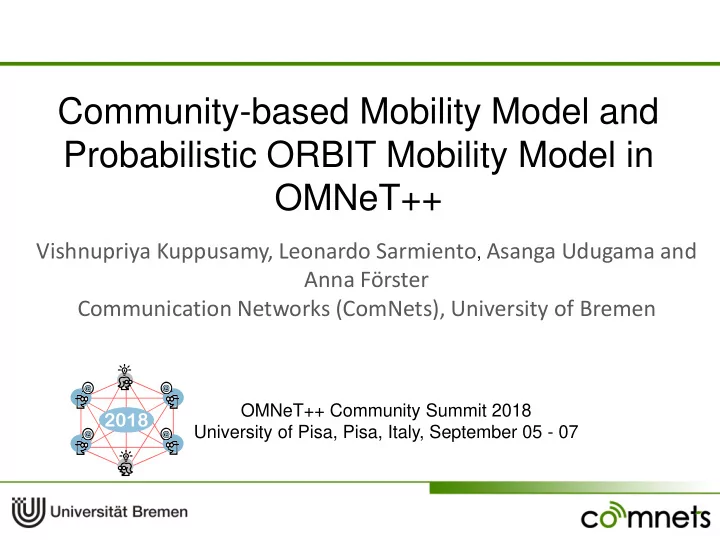

Community-based Mobility Model and Probabilistic ORBIT Mobility Model in OMNeT++ Vishnupriya Kuppusamy, Leonardo Sarmiento , Asanga Udugama and Anna Förster Communication Networks (ComNets), University of Bremen OMNeT++ Community Summit 2018 University of Pisa, Pisa, Italy, September 05 - 07
Motivation Performance Analysis of Opportunistic Networks (OppNets) Real tests beds – scalability Simulation models Mobility models Real-world traces Synthetic models OMNeT++ - RWP, RW, SWIM, and BonnMotion for traces Less traces available – need for realistic Mobility models based on Sociality and individual schedules 2
Overview Mobility models Community-based Mobility Model (CMM) Probabilistic ORBIT Implementations in OMNeT++ Evaluations and results Conclusion 3
Community-based Mobility Model (CMM) Users with strong social ties geographically co-located from time to time move towards or within the same region strongly associated nodes move as a community Social network interaction matrix Connectivity matrix Form communities Communities assigned to physical locations in simulation area called grids 4
Community-based Mobility Model Subsequent node movements – > influenced by the social interactions sum of interaction indicators of relationships between i and other hosts in the grid social attractivity factor = of a grid for a host i Total number of hosts in the grid 5
Flow chart - CMM Initialization phase Load or create interaction matrix Create communities Assign communities to grids Mobility Phase Calculate social attractivity Move 6
Probabilistic ORBIT Mobility Model Most users move in a terrain consisting of certain locations with different probabilities Macro-mobility model; not concerned about exact position co-ordinates but approximate locations Different movement patterns for users – individual schedules, weekdays, weekends – configurable Every user has a set of assigned locations and move around these locations with different probabilities 7
Flow chart - Orbit Initialization phase Get number of hubs, hub stay time, hub size Set intra-hub and inter-hub speed Mobility Phase Next hub location of node based on probability Move to a random position in the selected hub 8
Evaluation setup Random-waypoint to compare the differences Reconfiguration interval of 8 hours Node movements refreshed for CMM and ORBIT and not RWP 9
Results - Trajectories Random Waypoint CMM Movements for reconfiguration interval of 8 hours and simulation time of 24 hrs 10
Results - Trajectories ORBIT 11
Results – Total number of contacts CMM ORBIT Random Way-point 12
Results – Contact Times (Durations) CMM ORBIT Random Way-point 13
Results – Time between contacts ORBIT CMM Random Way-point 14
Results – Community size / Hub size ORBIT CMM 15
Conclusion and Future Work CMM and ORBIT implementations in OMNeT++ Functions verified using simulation configurations Use traces in the future to evaluate these models 16
Thank You 17
Recommend
More recommend